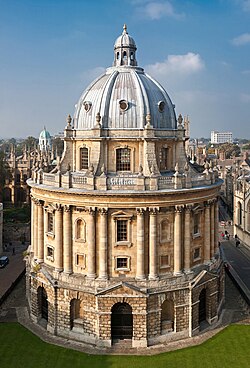Radcliffe Camera
| Radcliffe Camera | |
|---|---|
|
Radcliffe Camera, viewed from the University Church
|
|
|
Location within Oxford city centre
|
|
| Former names | Physics Library |
| Alternative names | Rad Cam or Radders or The Camera (colloquial) |
| General information | |
| Type | Academic library |
| Architectural style | English Palladian style |
| Location | Radcliffe Square, Oxford |
| Coordinates | 51°45′12″N 1°15′14″W / 51.7534°N 1.2539°WCoordinates: 51°45′12″N 1°15′14″W / 51.7534°N 1.2539°W |
| Construction started | 17 May 1737 |
| Completed | 1748 |
| Inaugurated | 13 April 1749 |
| Owner | University of Oxford |
| Technical details | |
| Floor count | 2 plus a mezzanine |
| Design and construction | |
| Architect | James Gibbs |
The Radcliffe Camera (Camera, meaning "room" in Latin; colloquially, "Rad Cam" or "The Camera") is a building of Oxford University, England, designed by James Gibbs in neo-classical style and built in 1737–49 to house the Radcliffe Science Library. It is sited to the south of the Old Bodleian, north of St. Mary's Church, and between Brasenose College to the west and All Souls College to the east.
The Library's construction and maintenance was funded from the estate of John Radcliffe, a notable doctor, who left £40,000 upon his death in 1714. According to the terms of his will, construction only began in 1737, although the intervening period saw the complex purchase of the site. The exterior was complete in 1747 and the interior finished by 1748, although the Library's opening was delayed until 13 April 1749.
Upon completion, Francis Wise was appointed as its first librarian. Until 1810, the Library housed books covering a wide range of subjects, but under Dr George Williams it narrowed its focus to the sciences. Williams brought the Library from a state of neglect up to date, although by 1850 the Radcliffe Library still lagged behind the Bodleian. It was at this point that Henry Wentworth Acland, then librarian, laid out plans for the Radcliffe Library building to merge with the University and the Library's collection of books to be moved to the newly constructed Radcliffe Science Library, which were accepted by the Library's trustees and the University. It was at this point that the building became known as the Radcliffe Camera, serving as a reading room for the Bodleian.
John Radcliffe (c.1650–1714) attended University College from the age of thirteen, becoming a fellow of Lincoln College at eighteen. He had a successful career in medicine, serving a number of high-profile, wealthy patients including William III and Queen Anne. He built up a large fortune and died childless. He is buried in St. Mary's Church, Oxford.
...
Wikipedia


